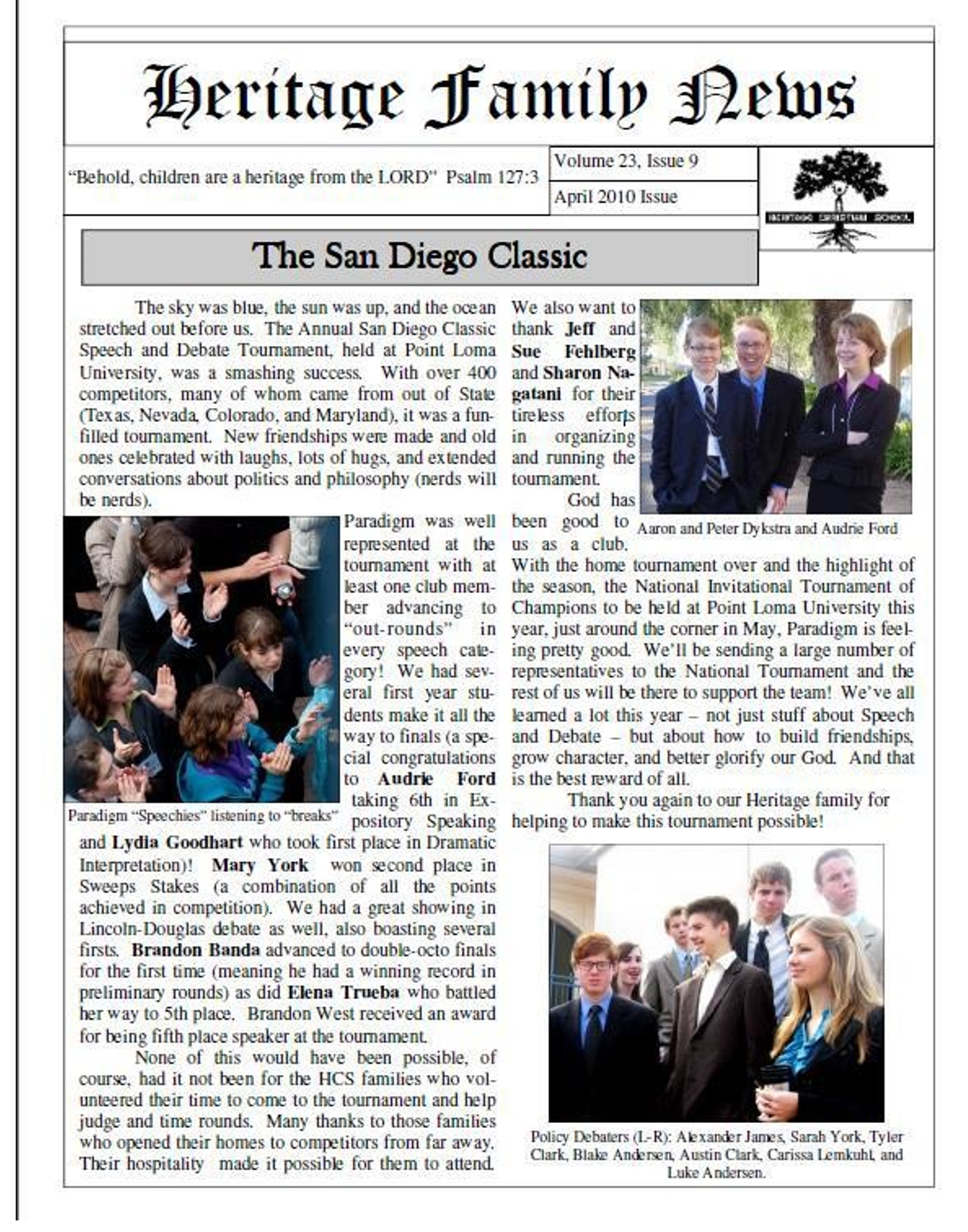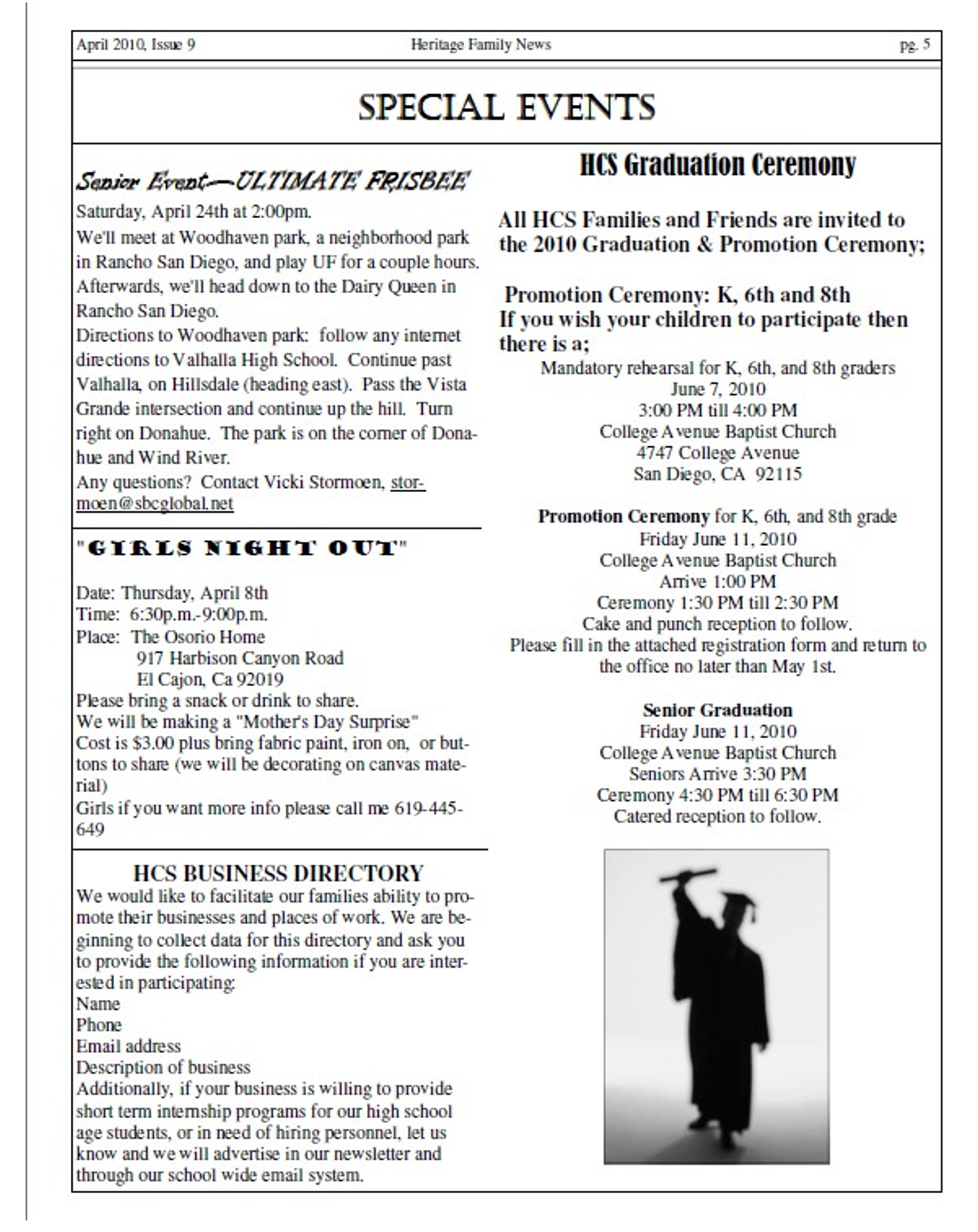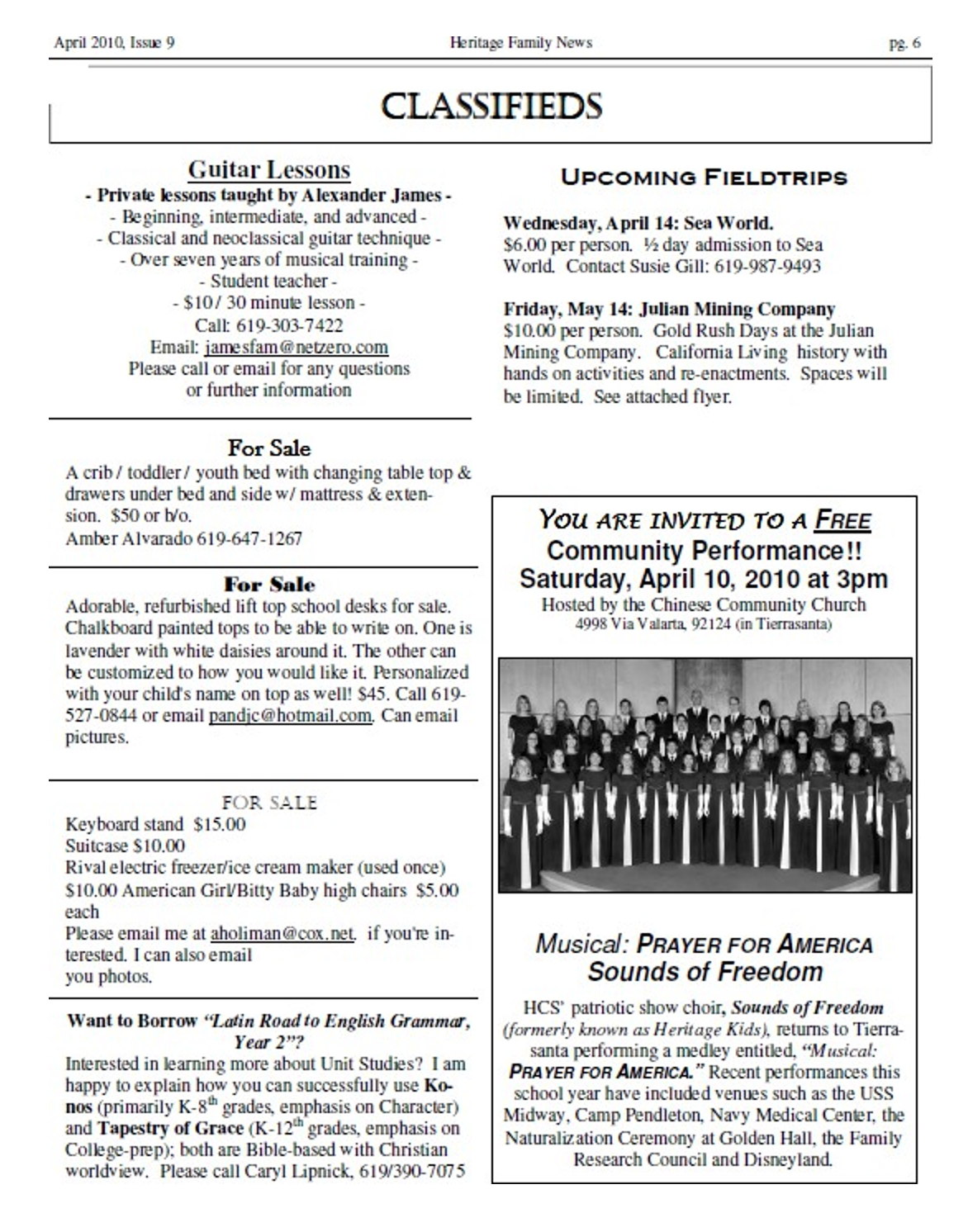26 Erika Stormoen – Sounds of Freedom: The Heritage Christian School Choir
Erika Stormoen is a Sophomore from South Bend, IN, and she is a California native, who is pursuing her degree in Health Sciences. This work was prepared for Jackie Kauza’s English W131, who states, “Erika’s exploration of her experiences in the Sounds of Freedom school choir offers a rich look at this discourse community and its practices and values.”
Sounds of Freedom: The Heritage Christian School Choir
The Heritage Christian School choir, Sounds of Freedom, is more than just a high school extracurricular activity. Instead, it has become an important part of the school’s identity. My journey as a member of this discourse community, singing second soprano, was a combination of cherished memories, lessons in choreography and harmonies, and the invaluable bonds of friendships forged with fellow choir members. From the high energy performances at various school events to the prestigious stages of venues like Disneyland, and even the White House, the Sounds of Freedom choir commanded attention with a profound sense of purpose and pride. We understood that our voices had the power to inspire and unite audiences. The Sounds of Freedom choir embodied a sense of community and a place where memories are made and etched into the fabric of our lives. Rehearsals were far from mundane and consisted of perfecting harmonies and choreography. With this paper, I intend to offer a comprehensive understanding of the dynamics, values, and profound impact of Sounds of Freedom choir as a discourse community. I will also highlight how the Sounds of Freedom choir continues to inspire and bring people together at Heritage Christian School.
A discourse community, as defined by John Swales (1990), refers to a group of individuals unified by shared objectives, communication practices, and specialized terminology specific to a given domain or context. This concept underscores the cohesive nature of groups that operate within defined parameters, fostering a sense of identity and common purpose among its members. Within the discourse community of Heritage Christian School, the monthly newsletter serves as a pivotal tool for intercommunication, fostering engagement among students and parents alike. Beyond its role to convey information, the newsletter offers a comprehensive glimpse into the vibrant aspects of school life. Through vivid imagery capturing the essence of school activities, the newsletter not only informs but also immerses its readers in the dynamics of the different clubs in Heritage Christian School. Moreover, the inclusion of personal anecdotes, quotes, and testimonials from parents and students instills the newsletter with a sense of credibility (Heritage Christian School, 2009). By providing a platform for diverse voices to be heard and celebrated, the newsletter amplifies the sense of belonging within the school community. By providing practical information such as upcoming performances and contact details, the newsletter enables readers to actively participate and engage with the choir, promoting a sense of involvement within the school community.
Within the discourse community of the Sounds of Freedom choir at Heritage Christian School, overarching goals, values, and practices revolve around fostering patriotism, musical expression, and a sense of unity among its members and audiences. The choir’s repertoire, predominantly comprised of patriotic songs and anthems, serves as an expressive method through which members evoke feelings of pride, love, and loyalty towards their country. Musical excellence is another central goal, pursued through rehearsals where choir members diligently refine their vocal techniques and master song lyrics to effectively convey the meaning and emotion in each piece.
Drawing parallels with the views expressed by Adderley, Kennedy, and Berz (2003), who characterized the high school music classroom as “a home away from home,” the Sounds of Freedom choir epitomizes this concept by providing its members with a supportive and nurturing environment in which to explore their musical talents and deepen their appreciation for music. Choir members not only can hone their musical skills but also forge enduring connections with their peers. Through Sounds of Freedom performances, choir members not only showcase their musical talents but also serve as examples of patriotism and unity, instilling a sense of pride and camaraderie among their audiences. Whether performing at school events, prestigious venues, or commemorative ceremonies, the Sounds of Freedom choir exemplifies the power of music in fostering a collective sense of identity and purpose. As a previous member of this discourse community, I have witnessed firsthand the profound impact of the Sounds of Freedom choir in shaping personal growth and fostering meaningful connections. Beyond the realm of musical achievement, participation in the choir has left me with a deeper appreciation for the values of patriotism and unity. Through rehearsals, performances, and shared experiences, I have forged enduring friendships and cultivated a sense of belonging that extends far beyond the stage.
With patriotism being a fundamental aspect of Sounds of Freedom’s identity, it is evident in the song choices, which consist of anthems and other patriotic compositions. Sounds of Freedom is comprised of high school students, each bringing their own unique life experiences and backgrounds to the group. The commitment to the choir and demonstration of shared love for our country bring together members of Sounds of Freedom. Hand choreography plays a significant role in practice and performances. These coordinated hand movements are synchronized with music and carefully choreographed to highlight the emotional impact of the songs, serving as another way to symbolize national pride. Recent research by Ibrahim et al. (2022) explores the potential role of arts programming in fostering critical consciousness among youth. The study examines how arts-based interventions can contribute to social justice awareness and activism among adolescents, shedding light on the broader societal implications of arts education. Communication within the choir involves various roles. The dynamics within the choir, including the roles of choir members, conductor, and audience, reflect the interconnectedness and shared engagement highlighted in research on arts programming among youth (Ibrahim et al., 2022). Choir members are responsible for both singing and performing the choreography. The conductor leads the choir, setting the tempo and dynamics of the performance. And finally, the audience listens attentively and reacts emotionally to the performance. Before each performance, choir members come together to rehearse. Under the guidance of the conductor, singing and hand choreography is finetuned to ensure that performances are executed with precision. During the performance, the conductor will signal the start of the music and maintain control over the choir members and audience. Throughout the performance, the audience engages by clapping along to the music, cheering at impactful moments, and sometimes even joining in and singing along with the choir. These enthusiastic and emotive responses from the audience underscore the significance of fostering social awareness and patriotism.
I had the privilege of sitting down with Jennifer, a member of the Sounds of Freedom choir and, coincidentally, my sister. We delved into her journey as a participant in our school’s patriotic high school choir. Jennifer reminisced about her time in the choir, describing it as an immensely enjoyable experience enriched with meaningful connections and a profound sense of patriotism. Inspired by attending my performances, she found the choir environment inviting and enjoyable, often joining me at rehearsals as well due to our familial connection. Jennifer expressed a particular fondness for the choir’s performances, especially those that involved visiting locations like Camp Pendleton to pay tribute to the courageous individuals serving in the military. “It was exciting and meaningful to connect with them through music and show our appreciation” (Stormoen, J. 2024). Reflecting on such experiences, she emphasized the profound impact of connecting with servicemen and women through music, describing it as both exciting and meaningful. Jennifer conveyed her deep respect for those who dedicate their lives to safeguarding peace and freedom, highlighting the choir’s role in fostering unity and national pride among students. In addition to performances, Jennifer shared insights into the structured rehearsal process, which focused on refining vocals and choreography and held two to three times a week. Recalling memorable performances, Jennifer (2024) recounted an encounter at Camp Pendleton, where a grateful family approached her to express their appreciation for the choir’s presence, underscoring its role in honoring and supporting service members. Jennifer’s involvement in the Sounds of Freedom choir not only fueled her passion for music but also shaped her academic and personal pursuits. Inspired by her experiences, she pursued a degree in music business in college and continued her musical journey through voice and music lessons post-graduation. Her journey epitomizes the transformative power of music in fostering patriotism, camaraderie, and personal growth among choir members. Jennifer’s narrative offers a glimpse into the profound impact of the Sounds of Freedom choir, showcasing its ability to instill a sense of pride, unity, and musical excellence among its members. As a testament to the choir’s enduring legacy, Jennifer’s journey serves as a reminder of the transformative power of music in shaping lives and fostering a deeper appreciation for patriotism and community. Moreover, her experiences align with the findings of the study titled “‘A Home away from Home’: The World of the High School Music Classroom”(Adderley, Kennedy, & Berz, 2003), which highlights the significant role of high school music programs in providing students with a sense of belonging and identity. Jennifer’s journey echoes the sentiments expressed in the study, underscoring the importance of music programs in fostering personal growth and community cohesion among students.
Shifting from Jennifer’s personal account to the exploration of community interaction, the monthly newsletter emerges as a pivotal communication channel within the discourse community surrounding the Sounds of Freedom choir. The newsletter offers a glimpse into the broader impact of the clubs, setting the stage for understanding the newsletter’s role in fostering community engagement. Serving as an informative hub, the newsletter plays a vital role in keeping students and parents up to date with school activities and achievements, including those of the esteemed Sounds of Freedom choir. By spotlighting upcoming choir performances, the newsletter cultivates a shared sense of pride and anticipation among readers, contributing to a vibrant and supportive community atmosphere. Moreover, the newsletter’s front-page feature, akin to a “club spotlight,” serves as a platform to showcase the achievements and contributions of various school clubs, including the Sounds of Freedom choir. Mirroring the recognition afforded to other clubs like the speech and debate team, the choir enjoys a moment in the spotlight, highlighting its significance within the school community. This visibility not only acknowledges the choir’s efforts but also celebrates its role in enriching school life through music and performance. Thus, the newsletter serves as more than just a source of information; it functions as a catalyst for fostering community pride reinforcing the shared values and camaraderie embraced by members of the discourse community.



The discourse community surrounding the Sounds of Freedom choir at Heritage Christian School represents far more than a mere extracurricular activity; it embodies a tapestry of shared values, experiences, and aspirations. Through our collective commitment to musical excellence, patriotism, and unity, we have created a vibrant and inclusive space where individuals from diverse backgrounds come together in harmony. From the exhilaration of performances at prestigious venues to the intimate camaraderie of rehearsals, every moment spent in the company of this choir has been imbued with a sense of purpose and belonging. As I reflect on my journey within this community, I am struck by the profound impact it has had on my personal growth and development. Through the Sounds of Freedom choir, I have not only discovered my passion for music but also forged lifelong friendships and cultivated a deep-seated appreciation for the power of collective expression. As I prepare to embark on the next chapter of my life, I carry with me the lessons learned and the memories cherished from my time in this discourse community. In the years to come, I am confident that the spirit of unity and camaraderie fostered within the Sounds of Freedom choir will continue to resonate, inspiring future generations of students to find their voice and embrace the transformative power of music.
References
Swales, J. (1990). Genre analysis: English in academic and research settings. Cambridge University Press.
Heritage Christian School. (2009). Heritage Christian School Newsletter. [Newsletter]. Stormoen, J. (2024, April 7). Personal Communication
Ibrahim, D. A., Godfrey, E. B., Cappella, E., C Burson, E. (2022). The art of social justice: Examining arts programming as a context for critical consciousness development among youth. Journal of Youth and Adolescence, 51(3), 409–427. https://doi.org/10.1007/s10964-021-01527-8
Adderley, C., Kennedy, M., C Berz, W. (2003). “A Home away from home”: The world of the high school music classroom. Journal of Research in Music Education, 51(3), 217–227.
Media Attributions
- Erika pic 1
- Erika pic 2
- Erika pic 3
